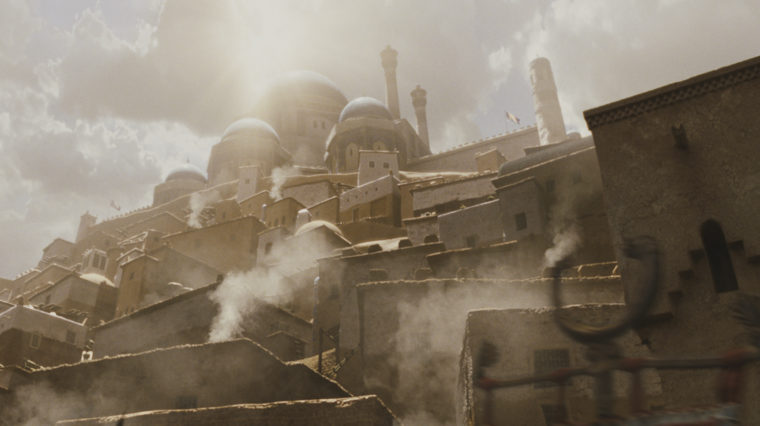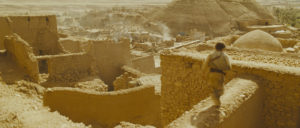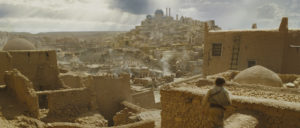
DIGITAL MEDIA WORLD : Prince of Persia – City Building
Sue Rowe, Visual Effects Supervisor for Cinesite, was on set throughout the shoot in Morocco and later at Pinewood Studios, collecting data for her team and preparing how they would handle the tasks they had been awarded, comprising 280 shots. The shoot ran from the end of August and into December. « Although the art department had provided quite adequate sets in many cases Director Mike Newell and Producer Jerry Bruckheimer came back from reviewing the footage wanting the whole production to be more, bigger and better. Can we add a couple of hundred buildings? Have a grander palace? Can that camera’s helicopter move swing even wider? » said Sue.
To create augmentations, the Cinesite team did some 2D compositing but most of their work was CG. For the two cities they created, Nazaf, King Sharaman’s home, and Avrat, his father’s burial place, they chose to use 3D after experience with other films. « You might plan a city as a matte painting and then discover you need to move the camera, requiring a matte painting projected onto geometry for 2 and 1/2 D moves and finally realise that these methods are not cost effective. It’s also frustrating for a director to be told when and where to lock off the camera, or be limited to a nodal pan, » said Sue. « Most directors expect to have full freedom. »
The cities were built from a combination of art department concepts and detailed survey of the sets at the time of shooting, photographing everything down to the last mosaic tile. Sue did further research at museums in London, especially a special exhibition at the Tate Britain Gallery called « The Lure of the East » showing works by British artists depicting the cultures and landscapes of the Near and Middle East, which she attended with Tom Wood.
It was a good introduction to the aesthetic they sought – smoky, dark areas contrasting with bright hot places. As northern Europeans, this look of the light struck them both, and certainly after spending six weeks out in Morocco immersed in the environment they knew the look to go for. The look of Cinesite’s cities was very different to elegant Alamut with its Indian influences. Nazaf and Avrat are run-down war cities comprising grittier urban sprawl.
While the set was limited to a facade representing only a tenth of the complete city, it gave the team enough information to build the remainder in a modular fashion, with a variety of different doors, arches and minarets to mix and match in buildings of a similar design and feel but all individually made. Sue reckons about 50 per cent of the shots were done in Morocco and when they returned to Pinewood Studios they could create effective backgrounds for Dastan’s parcours jumps performed on wires on a blue screen set.
The team’s real challenge was matching the lighting. They had taken shots on location as a guide, but of course the DP could never have replicated the lighting on the set. The artists touched up every set, adding more contrast and dark shadowy areas. Their 2D supervisor Matt Kasmir dedicated himself to matching the light in the two locations. They had taken silver and grey balls and HDRI cameras out for lighting reference, using a 4-camera 360 degree array to capture the light in a single shot, while their camera wrangling team recorded camera heights, tilts and angles, and lens grids for distortion. DP John Seale also used zooming cameras, not typical for a VFX film, which change focal length and lens distortion, and makes tracking 3D objects into live action more complicated and time consuming. This data was encoded into the shots.
Sue is particularly happy with the CG lioness the team created for a hunting sequence. She was on set when the real lioness the production had sourced was filmed on blue screen. But she was too contented and sleek for the role, refusing to roar on cue as the story’s half-starved, dangerous lioness had to do. Sue was quick to suggest a CG replacement.
Sue had worked on a black panther for « The Golden Compass » not long before this and started with the panther rig and fur, building up the lioness from there. « This lioness needed to be quite stylised, and Jerry Bruckheimer asked for bigger teeth, a wider mouth and mangy fur. It was on screen only for a few shots, but the way it suited the story made it worthwhile. We had a photo shoot at London’s lion park for hi-res images of claws, eyes, how moist the nose should be, even a lion with diseased fur. It’s important to capture how it should move and how a lioness moves differently to other big cats. »
Sue has learned that getting the surface of the skin right is critical for big cats, due to the strong layer of muscle under a thick layer of sebaceous fat with fur on top of that. « When the cat jumps onto a rock, the muscle snaps into place but there is some secondary movement in the fat layer to account for, then over this the fur wrinkles in a special way. These details add to the realism. Unlike an alien, an « unknown », people know instinctively how a lion will look and move. »
Massive crowd system software was used to populate the cities. They photographed the cities’ soldiers and citizens by putting them on a turntable, photographing them at 360 degrees, plus close ups of faces and hands. The images were projected onto CG doubles, rigged and cloth simulations were done. One of the opening shots, starting at the base of the city and rising to reveal the palace, is populated with hundreds of these agents, as well as camels, dogs, horses and goats. « It’s having movement and variety in such shots that sells them, » explained Sue. « We had motion capture sessions to collect data of people carrying out all kinds of likely activities, that we could snap onto the rigs. »
Other software in the pipeline was Shake and Nuke for 2D compositing, and Maya for the 3D. City dust and smoke was generated with Houdini and Maya fluids, and matte paintings for sky replacements were made in Photoshop.
The Hassassin fight sequences they were assigned to create CG weapons for were a lot of fun for the team. The hand animation of the whips, chains, claws, fire and blades was challenging, of course, because they had to match and coordinate the movement of the weapons to a choreographed, live action fight. The actors had enacted the sequences with only handles and stubs in their hands, making moves as if they had been hit.
The team needed to work out locations of all elements in 3D space, while looking at a 2D image of the footage. They relied on LIDAR scans of the set and, by combining these with motion tracking they could figure exactly where the actors were and how far the whips should stretch, or how much the shape should change, to make the necessary moves and hits against props to enhance the actors’ work. The 3D Supervisor Artemis Oikonomopoulou was a great help, adding glinting lights to the flashing blades.






